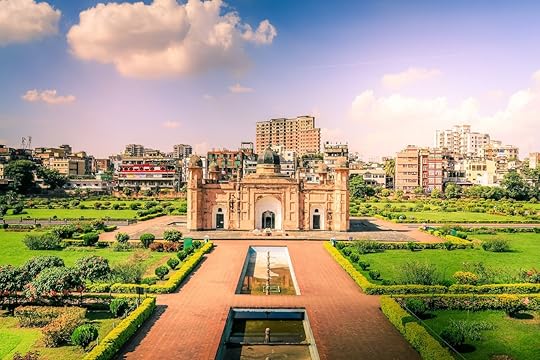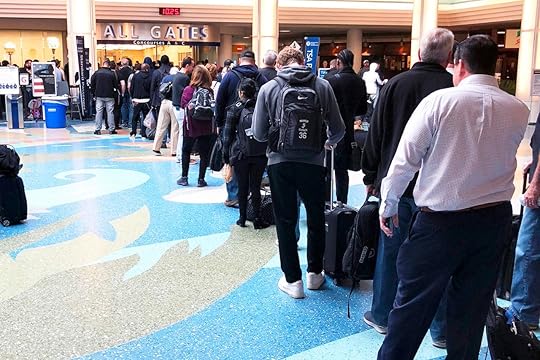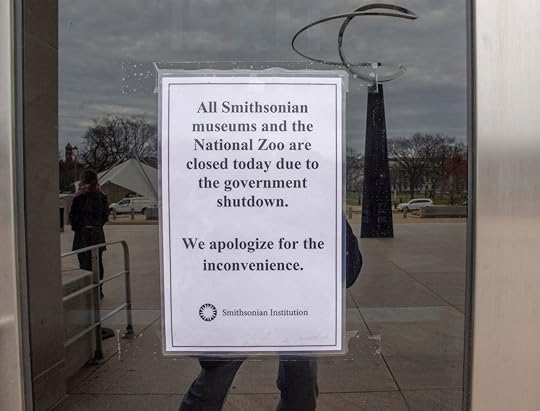Matador Network's Blog, page 1187
January 8, 2019
The best currywurst in Berlin

There’s a dizzying number of types of German sausages. To name a few: bratwurst, bockwurst, knackwurst, blutwurst, weisswurst — and the list goes on. By some accounts, there are more than 1,500 different kinds of wurst (sausage) in Germany. In Berlin, however, there is one kind of wurst that locals and tourists alike have deemed to be the best: currywurst. And it never would have come about if it weren’t for the British occupation after WWII and an enterprising street vendor.
Currywurst is a street-food favorite made of pork and served either mit (with) or ohne darm (without skin). It’s sliced into bite-sized pieces and smothered in house-made curried ketchup that can have either an intense tomato flavor or be sweet and tangy. The sausage is usually served with a gleaming portion of French fries or a brötchen (bread roll). The final touch that all currywurst has in common is a sprinkling of curry powder. This all comes piled on a plate for around four euros ($4.50).
In all, currywurst is an amalgam of cultures — tomatoes from America, sausage from Germany, and curry powder spices from India. New food, especially food that combines different influences as currywurst does, can help cultures connect. That was the case with the invention of currywurst in 1949.

Photo: frantic00/Shutterstock
According to the Currywurst Museum, the snack was invented by Berlin street vendor Herta Heuwer. She was selling sausages in the British-occupied section of Cold War Berlin when she struck a deal with the soldiers stationed in the city. If they gave her ketchup to pour over her sausages, she’d trade them alcohol, so the legend goes. The British also had a mix of Indian spices, and through an unknown series of events, Heuwer started sprinkling the spices over the ketchup. This was the beginning of a tale of female entrepreneurship that led to the creation of contemporary Berliner’s most beloved street food.
British laborers were loyal to currywurst due to its high protein, taste, and cheap price. Heuwer opened multiple shacks to sell her creation, and other vendors built off her success. Eventually, flavor won out and currywurst broke free from its working-class roots to be consumed and loved by everyone. Now, you can find currywurst around the world. Few people adore it as much as Berliners, though. The Currywurst Museum, which recently ended a 10 year run in Berlin to start a traveling museum, estimates there are 800 million portions of currywurst eaten in Germany every year and 70 million portions eaten annually in Berlin alone.
Heuwer sizzled her last Currywurst and closed up her sausage shop on June 30, 1979, but you can still treat yourself to a Currywurst at one of the over 2,000 stands that continue to operate in Berlin today.
The best places for currywurst in Berlin

Photo: Robson90/Shutterstock
Given its immense popularity, Currywurst is sold almost everywhere in the German capital. You can find it at fast food joints, street-side kiosks, and even ordinary restaurants across the city. You can enjoy it on top of the famous TV Tower at Alexanderplatz or right at Tegel airport when you arrive. Wherever you find yourself in Berlin, you’ll find people enjoying currywurst both day and night, lining up for the fare or huddled around the high-top tables by the city’s sausage vendor kiosks.
Curry 36

Photo: Curry 36/Facebook
Curry 36 is a favorite for both Berliners and tourists alike. With multiple locations spread across the city, this kiosk makes currywurst available to you wherever you are. The motto, “From Breakfast to Sunrise,” is taken seriously, and the stands are open nearly around the clock to provide for all of your sausage-eating needs. There’s both classic currywurst and a vegetarian option.
Locations: Mehringdamm 36, Hardenbergplatz 9, Hauptbahnhof, Europaplatz 1, and S-Bahnhof Warschauer Straße
Curry-Baude
One of Berlin’s best-kept currywurst secrets can be found just outside the entrance to the Gesundbrunnen train station in Moabit. This sausage stall looks like every other stand in the city, but a true currywurst connoisseur wouldn’t miss it. Curry-Baude has been around since the fall of the wall in 1989 and is a favorite of local residents. Run by Reina Lehmann, a skilled butcher with a well-established butcher shop, Curry-Baude offers homemade sausages served up with its coveted family ketchup recipe.
Location: Badstraße 5/Gesundbrunnen Bahnhof
Konnopke’s Imbiss

Photo: Konnopke’s Imbiß/Facebook
This popular snack stand has been in operation since 1930 and is found underneath the railway tracks at Eberswalder Station in the Prenzlauerberg district of Berlin. Konnopke’s Imbiss serves up many other German classics, but it became legendary among locals because it was the first place you could get currywurst in East Berlin in the 1960s. The stall remains a local favorite today. Both the stand’s vegetarian and vegan versions of currywurst taste pretty darn close to the traditional pork version.
Location: Schönhauser Allee 44 B
Witty’s Organic Food
If you’re looking for an organic and eco-friendly option for your currywurst cravings, Witty’s is the place for you. The chain proudly displays its various eco-certifications at each kiosk, and all of the products — from the sauces to the coconut oil — are 100% green. Along with your currywurst, you can enjoy Belgian-style fries made from an organic and regional variety of potatoes. The original location of this fast food joint can be found at Wittenbergplatz in Charlottenburg, but you can also visit their kiosk at Schönefeld Airport for one last bite of the Berlin delicacy before you leave the city.
Locations: Wittenbergplatz 5, Friedrichstraße Bahnhof, Schönefeld Airport
Bier’s Kudamm 195

Photo: Bier’s Kudamm 195/Facebook
If you’re looking for the classiest version of the Berlin street food, wine and dine at Bier’s Kudamm 195. Located on Berlin’s most famous shopping street, the kiosk is nestled between top designer boutiques and other high-end stores. Instead of using paper plates, Bier’s Kudamm serves Currywurst on porcelain, and your meal can be accompanied with a glass of sparkling wine or a bottle of Champagne. Celebrities and wedding parties have been known to frequent this establishment.
Location: Kurfürstendamm 195 

More like this: 7 destinations you’d never expect to have amazing street food scenes
The post How currywurst became Berlin’s favorite street food (and where to try it) appeared first on Matador Network.

Photo of a tourist riding sea turtle

After a photo showing a child sitting on an endangered sea turtle went viral, an investigation has been launched to identify those responsible. The photo, posted on Sunday, January 5 on this Facebook page, depicts an adult’s leg holding down the sea turtle on a boat in Sabah, Malaysia, while a child sits on its back. According to Business Insider, the photo’s caption on Facebook says, “to appeal to tourists, the tour and boat operator caught the turtle and put it on the boat for tourists to take pictures with.” Justifyingly, the photo has received hundreds of angry comments, generated widespread negative attention, and sparked an investigation.

Photo: 沙巴人情味/Facebook
The Sabah Wildlife Department (SWD) was made aware of the photo and sent a team to investigate, but it was not, however, able to find any evidence of the incident. The SWD raised the possibility that it may be a photo recycled from several years ago, but it’s still unsure.
The incident is especially alarming because the animal is a hawksbill turtle — a critically endangered species at “extremely high risk of extinction in the wild,” according to the IUCN Red List. Christina Liew, Sabah’s deputy chief minister and tourism, culture, and environment minister explained that catching a turtle, putting it on a boat, and riding it is unacceptable as it is forbidden by law in the state of Sabah.
Authorities are still investigating the incident, in the hopes of uncovering who facilitated the disturbing photo. 
H/T: Business Insider

More like this: 10 endangered animals to see (and save) before they’re gone
The post Viral photo of tourist riding endangered sea turtle sparks outrage appeared first on Matador Network.

Best alcohol-free retreats

There’s nothing wrong with a bit of overindulgence over Christmas, but as the new year dawns, we often find ourselves looking for something to help us re-energize. Cutting out alcohol is one of the best ways to feel instantly refreshed. Going teetotal increases energy levels, improves sleep, reduces depression, and revives lackluster skin and hair. But signing up for a “dry January” can be difficult without some encouragement and motivation. These alcohol-free trips will help you stick to your goal by offering calming natural environments, advice from health and fitness experts, and delicious nutritious alternatives to all that booze.
1. Absolute Sanctuary, Thailand

Photo: Absolute Sanctuary/Facebook
Absolute Sanctuary claims to be Asia’s leading wellness resort, and it is utterly idyllic. It’s located on the paradisiacal Koh Samui in a four-star hotel. There are various programs to choose from, all of which seem particularly apt for the new year, such as lifestyle change programs, weight management programs and, of course, detox programs. Meals at its “Love Kitchen” have all the hallmarks of a Michelin-starred restaurant but none of the unhealthy stuff.
$1,400 per person for a three-day detox program.
2. GI Jane Bootcamp, England
This women-only boot camp is for anyone left feeling a bit sluggish after Christmas and looking for a powerfully active way to start the new year. In addition to refraining from alcohol during the boot camp, participants partake in high-intensity physical training by experts. A week’s stay claims to ensure weight loss and emotional well-being, and while you should be prepared for some seriously challenging workouts, you’ll also have fun, a lot of laughs, and make some great friends. If you don’t fancy getting muddy in chilly January in Kent, there’s also camps in Thailand near the beach offered.
$1,257 per person for a week including accommodation and meals.
3. Shreyas Yoga Retreat, Bangalore

Photo: Shreyas Yoga Retreat – A Journey of Self-Discovery/Facebook
Shreyas is a boutique yoga retreat located just outside Bangalore, surrounded by nature, water, and its own organic gardens. It’s an alcohol-free center with wellness breaks that are focused on healing and rejuvenation, making it particularly appealing as a way to start 2019. Go all in with a Detox Package, which includes using yoga and naturopathy to cleanse the body from inside out. Diet is also essential to this process, and Shreyas’ menu includes plenty of fruit, vegetable juices, and salads. You’ll return home feeling thoroughly energized and toxin free.
$3,690 per person for a seven-night detox package.
4. The Detox Barn, England
The Detox Barn in Suffolk ticks all the new year retreat boxes: yoga, vegan food, juices, and absolutely no alcohol. In fact, it also cuts out sugar, dairy, and fish, and all ingredients used for meals are sourced from its garden. Plus, you’re signing up for a digital detox too, as no phones are allowed. To get you through the Instagram withdrawal symptoms, it offers daily yoga and meditation, walks in the countryside, massages, and reflexology. There are also demonstrations of how to make a great tasting smoothie so that you can continue your detox when you go back home.
$440 per person for a three-day reboot.
5. Santani Wellness Resort & Spa, Sri Lanka

Photo: Santani Wellness Resort & Spa
Five-star luxury is definitely the right way to start 2019. While the interiors are all retro modern with subtle lighting, it’s the surrounding landscape that is truly top notch. The rooms and communal areas have all been oriented so you have continual breathtaking views of the vast, green valley full of rice fields and tea estates. When it comes to wellness packages, it’s all about personalization. Your current lifestyle, physical and emotional state, and goals are all taken into account when signing up for a Santani program. Plus, the food is specially created to wean you off cravings for toxic treats like alcohol and refined sugar.
Contact Santani for prices.
6. Club Soda Mindful Drinking Festival, London
It’s hard to read the words “drinking festival” and not think of alcohol, but this London event will blow you away with the incredible mouth-watering array of non-alcoholic beverages on offer. It has alcohol-free everything, from gin to beer to cocktails, which are instead packed with refreshing fruits, vitamins, and superfoods. While you sip your hydrating drink, you can listen to inspiring talks about teetotal lifestyles, the benefits of sobriety, and even “happy hour yoga,” a special program that encourages you to get active rather than crack open a bottle. The Mindful Drinking Festival is held on January 12 and 13.
Entry is free. 

More like this: 9 wellness retreats you can actually afford
The post The 6 best alcohol-free trips to take to kickstart your new year appeared first on Matador Network.

January 7, 2019
Ryanair passengers bus to Greece

When you’ve just landed after a long-haul flight, the last thing you want is to board a bus for another leg of travel. Imagine how the passengers of this Ryanair flight felt when their plane from London, bound for Greece, landed in Romania instead and were told to catch a bus the rest of the way to Greece. The plane was supposed to arrive in Thessaloniki, Greece, by 10:00 PM, but fog at the airport caused a diversion. Normally the plane would land in Skopje, the nearby Macedonian capital, but instead, flight FR8582 landed at the airport in Timisoara, Romania, where transport to Greece isn’t exactly straightforward. Needless to say, the 200 passengers weren’t impressed.
Close to the Hungarian border, Timisoara is nearly 500 miles from Thessaloniki. While it might not sound like the most sensible or convenient landing spot, Ryanair does have a base at the Timisoara airport, making service recovery easier. Passengers and their family members expressed their outrage via Twitter.
@BBCBreaking My parents & 200 passengers of FR8582 @Ryanair from LDN to SKG have been stranded in Timisoara airport due to weather. No one in sight and no one answering phones. Babies and elderly spending the night in the cold. Please publish in order for @Ryanair to act tonight.
— Sanji A Hewson (@HewsonSanji) January 5, 2019
#Ryanair abandoned 200 people from London Stansted to Romanian airport. The flight FR8582 was originally going to Greece and got rerouted. The people are abandoned in Timi Soara Airport without being given any alternatives. The airport staff is forcing them to leave.
— Christina (@Christine_Kyr) January 4, 2019
Besides sleeping at the airport overnight, the only option Ryanair offered their passengers was an 18-hour bus ride to Thessaloniki. Eighty-nine passengers refused to board the bus, which was reported to be in poor condition, choosing instead to spend the night at the airport. Ultimately, the Greek government sent an Aegean Airlines plane to rescue the passengers, which arrived in Thessaloniki nearly a full day later than scheduled.
This latest incident probably won’t help boost Ryanair’s standing in the airline community. Ryanair was recently voted the worst UK airline for the sixth year in a row, and when surveyed, 90% of respondents (7,901) said it was the one airline they would never travel. 
H/T: Insider

More like this: 7 rights all air passengers have and should know about
The post Ryanair makes passengers take a bus to Greece after landing two countries away in Romania appeared first on Matador Network.

Most expensive tourist visas
Americans enjoy a powerful passport and plenty of benefits that make travel easy, but that doesn’t mean entry to every country comes cheap. Tourist visas to some countries add a relatively hefty financial burden to the trip-planning and budgeting processes for hopeful visitors.
Travel is always worth the expense, but make sure to leave some extra room in your budget if you’re an American planning to visit these countries. And keep in mind that these prices aren’t the same for all nationalities; visa issuances involve a decent bit of politics and delicate foreign relations, so what costs an American an arm and a leg may be priced lower for someone from a different country.
1. Russia: $270+

Photo: Reidl/Shutterstock
Visiting the iconic Red Square or skinny dipping in Lake Baikal is no easy undertaking. A tourist visa to Russia is among the most difficult travel visas for Americans to obtain, and its high price only makes it more challenging to acquire. The Consular Division of the Embassy reserves the right to request from applicants things like a statement from the employer regarding the preceding year’s wages, medical insurance, and even a certificate on the makeup of the applicant’s family.
What makes the price so high is the fact that, according to the Russian Embassy, “US citizens shall as a rule be issued multiple-entry business, private, humanitarian, and tourist visas that are valid for three years (36 months) from the date of issue of the visa” — and while single-entry visas start at just $90, multiple-entry visas start at $270 (and go up to $540 if you require a quick turnaround time).
2. The Democratic Republic of Congo: $200

Photo: Marian Galovic/Shutterstock
If your bucket list activities include observing wild mountain gorillas in the historic Virunga National Park or trekking Mount Sabyinyo, a dormant volcano, it’s going to cost you. A tourist visa to the Democratic Republic of the Congo costs $200 for Americans. Visa applications must be submitted several weeks prior to departure as “no Congolese visa will be issued at any port of entry,” according to the Embassy of the Republic of Congo. However, the tourist visa grants Americans access for 180 days and allows multiple entries, so it makes for a good excuse to explore other parts of Africa on the same trip.
3. Afghanistan: $195

Photo: Mark Time Author/Shutterstock
Make sure to set aside an extra $195 if you hope to check out the Buddhas of Bamiyan, the Gardens of Babur, or the awe-inspiring Blue Mosque in Afghanistan: With a $160 visa fee and $35 processing fee, tourist visas for Americans don’t come cheap. Moreover, your signed and notarized visa application plus all necessary documents must be delivered to the Afghan Consulate in New York City, Beverly Hills, or Washington, DC. Once approved, the visa does grant access for a 30-day stay, so make sure to set aside ample time for the trip.
4. Nigeria: $180

Photo: Adamawa/Shutterstock
The striking landscape and natural wonders of Nigeria are a siren’s call to many an adventurous traveler, but be aware of the steep price of a tourist visa as you plan your visit. While trying to see the face in Zuma Rock or wandering the enchanting sacred forest of Osun-Osogbo is more than worth it, be aware of the semi-challenging visa acquisition process before you depart.
Requirements for obtaining a tourist visa for Nigeria include submitting documents like a letter of invitation from a host who accepts full responsibility for you (plus the data page of your host’s passport) and evidence of funds to cover your stay in Nigeria — plus, the $180 fee is non-refundable (as are most visa application fees).
5. Bangladesh: $160

Photo: Social Media Hub/Shutterstock
The bustling and historically significant country of Bangladesh appeals to a variety of curious travelers, not least for attractions like the 17th-century Lalbagh Fort or the paradisiacal St. Martin’s Island. However, the hefty $160 visa fee must be factored into your budget, and keep in mind that Bangladesh does not allow online applications from all countries. Even if you complete the process online, according to the Department of Immigration & Passports, you’ll need to print your application and pay a visit to the nearest visa office or Bangladesh Mission to file your paperwork.
6. Sierra Leone: $160

Photo: robertonencini/Shutterstock
If you dream of visiting the remote Banana Islands or the Tacugama Chimpanzee Sanctuary in Sierra Leone, make sure to include the $160 visa fee as you tally up the total cost of your trip. And don’t procrastinate: If you want to receive your visa the same day, that’ll be an extra $50 in expediting fees.
According to the Embassy of Sierra Leone, one of the requirements for anyone wishing to travel to the country is a copy of their itinerary or a round-trip ticket — and “In some instances, the consular office will invite applicants for [an] interview.” In addition, your paperwork must be mailed via USPS Priority Express, and visa payments are only accepted in the form of a money order or cashiers check (no cash or personal checks accepted).
7. Uzbekistan: $160

Photo: Christophe Cappelli/Shutterstock
Highlights like Registan and Gur-e-Amir make the country of Uzbekistan a bucket-list destination for many travelers — especially since Central Asia is officially trending — but getting there isn’t necessarily cheap. Still, the Ministry of Foreign Affairs of the Republic of Uzbekistan allows American citizens to use a simplified online procedure for acquiring their visas and even provides visa-free transit entry for stays up to five days. Otherwise, visa processing takes up to 10 working days and foreigners must be invited by an organization, company, or citizen in Uzbekistan. 

More like this: The 25 places you need to travel to in 2019
The post The 7 most expensive tourist visas to save up for appeared first on Matador Network.

How the shutdown is affecting travel

The government has been shut down for about two weeks, and travelers are really feeling its negative effects. While the shutdown isn’t making travel impossible, it’s thrown a wrench into many aspects of the travel industry that have resulted in delays, inconveniences, and even safety concerns for travelers. The longer the shutdown lasts, the more issues are likely to arise. While TSA agents remain working, an increasing number are taking “sick days” due to being forced to work without pay, causing delays for travelers. Here are some of the inconveniences the shutdown is causing for travelers and how they could affect you.
1. TSA personnel shortages

Photo: Carolina K. Smith MD/Shutterstock
Airport security lines are where travelers are feeling the government shutdown the most. Last week, hundreds of TSA workers called in sick as they aren’t getting paid until the shutdown ends. Hydrick Thomas, president of the national TSA employee union, told CNN, “This will definitely affect the flying public who we (are) sworn to protect.” While the TSA insists the shutdown will not negatively impact its ability to keep passengers safe, the staffing issue is growing worse. At Seattle’s Sea-Tac Airport, TSA agents are threatening to quit. Cairo D’Almeida, local union president, told a local news outlet, “If they don’t get a check within two weeks, they have to make a decision whether to… get a part-time job or quit TSA altogether.” None of these options is particularly encouraging. Although their pay is backlogged and they will be compensated for their time eventually, there’s no telling when that will be.
2. National park chaos

Photo: Talulla/Shutterstock
Most national parks remain open during the shutdown, but they have been forced to furlough much of their staff. This has caused parks to cut visitor services like restroom maintenance, trash collection, and road repairs. The result is terrible trash buildup and litter throughout the parks, along with decreased safety for park visitors. In The Guardian, former National Parks Services director Jonathan Jarvis said, “Leaving the parks open without these essential staff is equivalent to leaving the Smithsonian museums open without any staff to protect the priceless artifacts.”
Indeed, with millions visiting national parks without ranger support, there is an increased risk of injury and damage to the park itself. On Christmas Day, a hiker fell to his death in Yosemite — an incident that may have been prevented had a ranger been present to warn him of the danger. Similarly, a hiker broke his leg at Big Bend National Park last week and, due to staff shortages, had to rely on the help of other hikers before rangers could arrive. Snow removal services are also taking a hit, causing parks like the Rocky Mountain National Park to close roads higher than 8,000 feet.
3. Museums closed

Photo: TJ Brown/Shutterstock
Museum-goers are among the most heavily impacted during the shutdown. Nineteen Smithsonian museums and Washington, DC’s National Zoo closed their doors last week. Perhaps most devastatingly, the zoo’s live animal webcams also ceased to be operational. Elliot L. Ferguson, the president and CEO of Destination DC, said, “While we’re disappointed the Smithsonian Institution museums and the National Zoo, National Gallery of Art, and National Archives are temporarily closed, the vast majority of things for visitors to see and do throughout Washington, DC’s neighborhoods remain open.” The tourism office has also issued a list of sites in DC that remain open to keep tourists occupied until the shutdown is over.
4. Air traffic control crisis

Photo: Mark Agnor/Shutterstock
Air traffic controllers continue to work without pay, but the FAA has closed its training academy during the shutdown, which may exacerbate staffing shortages and cause delays. Paul Rinaldi, president of the National Air Traffic Controllers Association (NATCA), said in a statement, “This staffing crisis is negatively affecting the National Airspace System, and the shutdown almost certainly will make a bad situation worse. Even before the shutdown, controllers have needed to work longer and harder to make up for the staffing shortfall.” Indeed, according to the NATCA official website, the “government shutdown means hiring and training delays, worsening air traffic controller staffing crisis.”
Accident investigation is also taking a hit. Last weekend, a fatal plane incident in Saginaw County, Michigan, was not investigated due to a lack of resources. Instead, the plane wreckage has been moved to a salvage facility where it awaits investigation once investigators return to work.
5. Passport processing delays

Photo: Atstock Productions/Shutterstock
If you’re applying for your first passport or hoping to renew your existing passport in an efficient manner, you may be disappointed. Passport processing services will remain functional, but only “as long as there are sufficient fees to support operations,” according to a State Department official. This means that if a passport agency is located in a government building affected by a lack of funds, it may be closed to the public. The Bureau for Consular Affairs website will not be updated except with urgent security information. For now, scheduled passport and visa services are still operational, but if funds run dry or are reallocated for other services deemed more “essential,” passport processing may see significant delays — potentially hindering people’s travel altogether. 

More like this: National parks are overflowing with trash and feces amid government shutdown
The post Every way the government shutdown is affecting travel appeared first on Matador Network.

Lion Air delays mean fried chicken

As anyone who’s been to an airport knows, traveling is not all white-sand beaches and swaying palm trees. Crazy delays, unpredictable weather, and overcrowding can make even the most well-traveled feel a bit jittery when they head to the airport. In Philadelphia, the well-loved chain Popeyes Louisiana Chicken tried to ease some stress by offering “emotional support fried chicken.”
How innovative, you might be thinking. How avant-garde of them!
Brilliant as this Popeyes stunt may be, it’s not the first company to use fried chicken as a means of easing airline woes. Just last year, on the other side of the world, I too was the recipient of a “fried chicken” appeasement. As it turns out, Lion Air, a budget airline based in Indonesia, has been dishing out boxes of greasy comfort food for years.
The Lion Air fried chicken experience is far from the carefully manicured Popeyes emotional support fried chicken, though. I saw it first hand in the Yogyakarta airport. It’s a one-story building with two terminals, a handful of restaurants, and a large waiting room stacked with chairs and free water coolers. It’s modern and clean, although after watching a couple carelessly walk back and forth through the metal detectors to retrieve something (and accidentally smuggling in my own bottle of water), the airport security left a bit to be desired. Nevertheless, the cozy waiting room felt like a pleasant spot to relax before boarding.
Then I noticed the little TV screen attached to the ceiling listed in bold red type that every outbound flight was DELAYED. We had about an hour before takeoff and figured that we were in no rush. Surely, we thought, they’ll work this all out. We found a couple of seats and struck up a conversation with other travelers who were also lamenting their flight status. The minutes turned to hours, but when we hopelessly asked the cheerful flight attendants at our gate they told us, “We don’t know,” and flashed a smile.

Photo: muliaphoto/Shutterstock
The room became steadily more crowded and hot. Yogyakarta’s climate is that potent brand of tropical humidity that can’t withstand many people crammed into a tight space. After countless hours of one flight taking off for every five that were delayed, the room’s weak air conditioner and now empty water coolers did not stand a chance against the ever-increasing surge of displaced passengers.
Somewhere around the four-hour mark, we were exhausted, hungry, and honestly, really worried. We had no place to stay, could not speak the language, and no real idea of if we were ever going to take off. It’s hard to know what to do when a flight is canceled in your home country, let alone when you’re abroad.
Lion Air, though, was not worried. In fact, it appears the staff had plans for just such a time as this. With even brighter grins plastered on their faces, the attendants working our gate hopped on the loudspeaker to announce that, no, they still did not have an update, but what they had was even better: free boxes of freshly fried chicken.
Incredibly, it worked. My husband and I watched dumbfounded as passengers happily scrambled to the front of the terminal to stake claim to their fried goods. A shoulder shrug and a short line later, we too were biting into our penance. The grease from the still warm chicken dribbled down our chins, and we felt a bit better with every mouthful.
Eventually, we made it onto the plane. We crossed the tarmac in the dark, climbed the steps to the small aircraft, and immediately fell asleep in our seats, stomachs full of fried chicken.

Photo: Wien Kusuma/Shutterstock
Recently, I reached out to Lion Air to see if I could get any insight into how often this happens or what the purpose of the fried chicken handout actually is. But alas, the response has been a resounding silence, much like the one I enjoyed in that tiny Indonesian airport.
However, a host of scathing reviews posted on Tripadvisor in recent years shows that I wasn’t alone in being bribed with fried chicken. The posted stories are eerily similar to the one I experienced: The flight is incredibly delayed, there is no information given, but fried chicken is delivered to passengers.
While flight delays are inevitable with travel, fried chicken is not. Yes, Lion Air leaves a lot to be desired as an airline. Delays are just the tip of the iceberg for reasons to avoid the airline if possible. But I’ll be honest, this little trick likely cost them very little and put a smile onto a lot of angry faces. Say what you will, Lion Air knows how to manage a disgruntled crowd.
Other airlines could take a page out of their book. When all else fails, simply smile, play dumb, and provide fried chicken. 

More like this: This budget airline is the best way to get to Europe right now
The post This airline bribes delayed passengers with fried chicken appeared first on Matador Network.

Indian curries you need to try

People are creatures of habit — especially when it comes to food. It’s simply easier to stick to tried-and-true dishes that we know are delicious. With Indian food, that often means ordering (and re-ordering) the regular recommendations of chicken tikka masala, garlic naan, dal, and biryani. Indian cuisine, however, is much more than that.
The menus of many Indian restaurants in the US and UK are typically dominated by Mughlai dishes, a category of north Indian food. Some classic orders lack any traditional roots to a place in India at all, though. Chicken tikka masala, for example, is like the General Tso’s Chicken of Indian cuisine and was invented in Glasgow, Scotland.
Yet Indian cuisine is by no means a monolithic entity. In a vast country like India, the cuisine changes along with the language, culture, religion, traditions, and culinary customs. While northern India relies more on wheat, southern India uses mostly rice. Along coastal regions, fish, coconut, and tamarind are recurring ingredients. Some of the most popular sweets hail from eastern India. In western India, dried lentils, beans, dairy, and millet-based bread are plentiful.
By leaning towards the same go-to dishes like chicken masala, vindaloo, and rotis, you’re barely scratching the surface of what Indian food has to offer. There’s a wide world of curries (a catch-all term for a dish made of meat or vegetables cooked in a sauce) out there. Be adventurous and skip the typical must-haves on restaurant menus. Instead, get to know and love these Indian dishes.
1. Rajma masala

Photo: StockImageFactory.com/Shutterstock
Rajma masala is a simple but beloved Punjabi dish made with red kidney beans cooked in a spicy tomato and onion sauce with a few spices. This creamy and warming dish is perfect for wintertime and is best paired with chawal (rice) or chapati (unleavened flatbread).
2. Rogan josh

Photo: StockImageFactory.com/Shutterstock
An often forgotten dish on Indian restaurant menus, rogan josh is a signature Kashmiri dish with Persian origins. The word rogan means “oil” in Persian while josh means “intense heat.” Typically made with lamb or mutton, this hearty and aromatic curry is known for its fiery red color and heavy dose of warming spices like whole clove, cardamom, and cinnamon. Its smoky and sweet taste comes from its base of onions caramelized in plenty of ghee (clarified butter).
3. Sarson ka saag

Photo: StockImageFactory.com/Shutterstock
Another classic Punjabi dish, sarson ka saag is a vegetarian curry made with mustard greens, spinach, and other leafy vegetables. Sarson means “mustard” in Hindi, and saag means “greens”. This earthy and richly flavored dish is slowly simmered on a low flame and finished off with a dollop of ghee. It’s best paired with makki ki roti, an unleavened flatbread made with maize flour.
4. Macher jhol

Photo: Santhosh Varghese/Shutterstock
Fish is an integral component of Bengali cooking in eastern India, and macher jhol is a must-try dish for any seafood lover. This traditional, spicy fish curry is cooked in mustard oil and seasoned with ground black and yellow mustard seeds, turmeric, onions, and green chilies.
5. Baingan bharta

Photo: StockImageFactory.com/Shutterstock
Baingan bharta is a smoky eggplant dish that’s known for its sweetness. It’s prepared with eggplant, tomato, onion, garlic, and simple aromatic spices and served hot. This flavorful and healthy vegetarian dish is somewhat like a warmer version of baba ghanoush, a cold Middle Eastern dip made with pureed roasted eggplant. Rather than pureed, however, the ingredients in baingan bharta are mashed together.
6. Sambar

Photo: jayk67/Shutterstock
It’s impossible to compile a list of must-try Indian dishes without including the humble sambar. This spicy and tangy stew is made with lentils, vegetables, and a tamarind and coconut broth. It’s ubiquitous in southern India, and every state and home in the region has its own take on the dish. This soul-soothing dish is often paired with coconut chutney and eaten with rice, idlis (rice cakes), dosas (a type of pancake made with chickpea flour), and vadas (fried snacks).
7. Kerala-style beef fry

Photo: Santhosh Varghese/Shutterstock
While not many people associate India with eating beef, the southern Indian state of Kerala is famous for its beef fry. A recipe beloved by many, a traditional Kerala beef fry is typically prepared with onions, ginger, garlic, curry leaves, and slivers of coconut sautéed in a generous amount of coconut oil and topped with a medley of spices like black pepper, cumin, cloves, and roasted chilies. Pair it with parotta (a multi-layered flatbread) and prepare for your perspective of Indian cuisine to be forever changed.
8. Kadhi

Photo: StockImageFactory.com/Shutterstock
Every region in India has a distinct version of kadhi, but at its most simple, it’s a spiced, yogurt-based curry with a balance of sweet, sour, and savory flavors. It’s perfect for anyone who prefers to steer clear of spicy Indian dishes. Kadhi is thickened with chickpea flour and spiced with dried red chilies, cumin, fenugreek, and mustard seeds. While the Punjabi version of Kadhi is thicker and comes laden with deep-fried besan pakoras (chickpea flour dumplings), Gujarati kadhi is slightly thinner and sweeter to taste. In south India, coconut, ginger, garlic, and curry leaves are added, as well. Kadhi is often eaten with rice and roti.
9. Kheema

Photo: StockImageFactory.com/Shutterstock
Kheema is a traditional Indian dish made with minced meat that’s simmered with spices like cumin, coriander powder, and garam masala (a mixture of several ground spices). Typically made with mutton, beef, or chicken, kheema (which translates to “minced meat”) is like the chili of India and often comes with potatoes and peas. The flavorful combination of onion, garlic, ginger, tomatoes, and earthy spices with ground beef makes this a hearty and comforting dish in the winter.
10. Goan prawn curry

Photo: PI/Shutterstock
Seafood is an integral part of the cuisine in the tiny state of Goa on the western coast of India. Seafood lovers would be remiss not to try Goan prawn curry — a spicy and sour coconut-based curry seasoned with tamarind. It’s sweet and sour and pairs beautifully with prawns. This fragrant curry is rich in flavor and often served with steamed rice.
11. Pav bhaji

Photo: StockImageFactory.com/Shutterstock
Think of pav bhaji as the Indian version of sloppy Joes — but vegetarian. This dish is a popular street food in India and is essentially a spicy, tangy medley of bhaji (vegetables) simmered in an onion and tomato base. Spiked with spices, this delicious dish is served with pav (a Portuguese bread common in many western India street foods), lemon slices, and a sprinkling of red onions. 

More like this: Why Mumbai’s most popular street foods are made with Portuguese bread
The post 11 Indian curries that are infinitely better than chicken tikka masala appeared first on Matador Network.

Best ski resorts for Presidents' Day

Don’t let the fear of holiday crowds keep you at home this Presidents’ Day weekend. It’s time to use those advanced trip-planning skills to capitalize on what most people don’t: a three-day window at some of the country’s smaller resorts. So take advantage of the mid-winter snow, load up the roof rack, and hit the road. A long weekend is coming and here’s where to go.
1. WEST COAST: Mt. Baker, Washington

Photo: vanpeltj87/Shutterstock
The thing about skiing in Washington is that — unlike the ski hubs of Utah, Colorado, and Tahoe — you never have to avoid the best mountains during holiday peak times for fear of spending your whole day waiting just to wait some more. Mt. Baker often boasts the deepest base in the US and has big-mountain terrain that rivals Squaw Valley’s KT-22 lift and the back bowls of Vail. Best of all, you never need to worry about what day it is or what month, or even check the weather. It’s probably snowing, and there are never massive crowds. Because of its far-north location, Mt. Baker tends to attract only die-hards to its steep terrain and deep powder, and a lift ticket runs you less than $70.
2. CENTRAL ROCKIES: Purgatory Resort, Durango, Colorado

Photo: Kara Grubis/Shutterstock
At Purgatory, not only are you reducing the time queued in lift lines, but you’re also freeing yourself entirely from I-70’s nightmare-inducing ski traffic gridlock. Tucked in the San Juan Mountains of southwestern Colorado, Purgatory Resort is actually more than three hours from the nearest interstate and equally as far from anything resembling a traffic jam. Plus, you can check out the badass town of Durango for après fun and, in a telltale sign of a good ski town, even have a desirable meal downtown.
3. NORTHERN ROCKIES: Lost Trail Ski Area, Sula, Montana

Photo: Lost Trail
The Lost Trail Ski Area is the stuff of legend for powder skiers looking to get away from it all. The powder is deep — 325 inches of the stuff falls on the resort’s 60 runs per year — and the terrain offers up over 1,800 vertical feet of intense, knee-testing pleasure, plus some of the best views of the Selway Bitterroot Wilderness from high atop Lost Trail Pass. Located on the border of Idaho and Montana, the resort is essentially in the middle of nowhere. Aside from a dedicated crop of hardy Missoulians, not many from outside the immediate area make the trek. Indeed, most keep on driving to Grand Targhee and Jackson Hole. And, in what is either a nod to the days of yore or solid proof that the staff is too busy shredding the gnar to care, Lost Trail’s website looks like it’s straight out of the late ’90s. If you can find the place, you’re in for a true Presidents’ Day treat.
4. MIDWEST: Shanty Creek, Bellaire, Michigan

Photo: Shanty Creek Resorts
Before you point out the lack of towering peaks in the area, it’s worth noting that Kid Rock misses out on half the fun of northern Michigan by only sticking around for the summer. Sure, it’s cold, but contrary to popular belief, there’s decent skiing in northern Michigan. And while the midwest’s holiday masses head to Vermont, you can ski right up to the lift at Shanty Creek. There are 53 runs accessed by 11 lifts and 450 feet of vertical. (Come on, it’s Michigan, give them a break — at least the mountain isn’t built on top of a landfill.) Plus, three separate village areas — Schuss Mountain Village, Cedar Village, and Summit Village — make up the resort. In a nod to Euro-style piste productivity, you can ski between two of the three. If you have a pair of cross-country skis, you can even host your own three-hill ski bonanza and pub crawl across the entirety of the resort.
5. NORTHEAST: Black Mountain, Jackson, New Hampshire

Photo: Black Mountain/Facebook
Black Mountain is everything charming about New England skiing. Here in central New Hampshire, you’ll find crisp morning groomers with a dash of powder in the trees, fast steeps, and a few double-black gladed runs off the peak. There’s plenty of live music in the Lostbo Pub, as well. What you won’t find on the resort’s 50-plus runs and six lifts are the half-hour lift lines prevalent at many of the region’s larger resorts. You’ll park close in, and a lift ticket only runs $59. And should your long weekend command further adventure, there are three additional resorts just up the road. 

More like this: The best resorts for gay ski week
The post 5 ski resorts to go to this Presidents’ Day to avoid the crowds appeared first on Matador Network.

Family travel resolutions for 2019

It’s time for more ambitious family travel goals. The kids are older and they’re ready for more than an overpriced Disney weekend. Maybe it’s time to take them camping. Perhaps you want them to start appreciating art. Or maybe you just want your little ones to be more adventurous. Whether in Broward County or Buenos Aires, there’s a great big world ready to be seen. Follow these family travel resolutions — and start exploring it.
1. Spend more time in the great outdoors.

Photo: Monkey Business Images/Shutterstock
You know you should be introducing the kids to the splendor of the outdoors, but somehow hiking with little ones seems too daunting, and the most popular parks are always jammed. If you follow these simple tips — like choosing family-friendly trails and going early in the day — you’ll find it not so hard get the kids started on a childhood of hiking.
Plus, you should look into state parks, which get less attention than national parks but can be equally epic (and less crowded). And at a place like Anza-Borrego State Park, your kids can also check out amazing metal sculptures, like one of a dragon that seems to be swimming through the sand.
2. Introduce the kids to arts and culture.

Photo: NadyaEugene/Shutterstock
Adding culture that your kids will appreciate into your travels is easier than you think. Sometimes it’s as simple as picking a place where cool art is part of the landscape — as it literally is at above-mentioned Anza-Borrego. Or, if you’re in Barcelona, don’t say you’re going to see the work of admired architect Gaudí at the Sagrada Familia Cathedral. Instead, challenge your kids to figure out what natural features inspired Gaudí’s bizarre shapes. (And pre-book your tickets to visit.) Or skip the Sagrada Familia and see Gaudi’s Casa Milà instead, where the roof spires look like Star Wars stormtroopers and, inside, you can see an early-20th-century-modeled apartment.
Strategies abound to sneak culture into your travel. You can even get kids to enjoy museums by, say, turning a visit to a fine arts gallery into a scavenger hunt for certain images or trying to find all the paintings depicted on a museum map. As long as you keep the kids rested and well-fed, and do the cultural stuff early in the day, you’ll be surprised how much they’ll get out of it.
3. Explore your own city.

Photo: James Kirkikis/Shutterstock
There’s hardly a more worthy travel resolution than exploring the richness of your own backyard. You’ll save money and stop spending Saturdays taking the kids to the same neighborhood playground. It’s also a great way to get ready for bigger vacations later — by sparking your kids’ curiosity sooner.
Say you want to introduce the kids to culture on your travels (see Resolution #2). Before jetting off to an expensive city, take them to more ethnic restaurants in your own town. Also, cities everywhere are embracing street art. Go check some out in your own city, or find outdoor summer plays, or just go to a science museum. Even if you live in smaller towns like Flagstaff, Arizona, or La Crosse, Wisconsin, both of which are some of the coolest towns in America, you can visit excellent museums like the Lowell Observatory (Flagstaff) or Dahl Auto Museum (La Crosse).
4. Be more adventurous.

Photo: Tropical studio/Shutterstock
Whether exploring your own city or a village an ocean away, travel can be a great way to teach your kids to be more adventurous. One way to do this is with new foods. Try foods that seem unusual but that your kids are pretty sure to like. Opening a banana leaf for lunch may be intimidating, but the nacatamales inside are a yummy Nicaraguan dish that’s sure to please. Fishhead pie in Mousehole, Cornwall, is probably overdoing it, but a tasty pasty (a Cornish empanada) will go down well.
The other way to be more adventurous is to do something new on every trip. Surfing is a pretty obvious must-try on your Kauai vacation, but a less typical beachside activity could be riding on fat bikes. If you’re in Italy, take the kids to a cooking class in Chianti or learn to ride gondola boats in Venice.
5. Go somewhere everyone will actually enjoy.

Photo: Max Topchii/Shutterstock
Travel shouldn’t be an either-or situation. If parents like a place, it doesn’t mean it’s the wrong choice for the kids — or vice versa. We can think of a whole bunch of epic family trips that everyone can appreciate. Whether Chile or Chattanooga, most great destinations offer a mix of things to do — from sandboarding to river-rafting — so there’s usually something for everyone.
Even locations that seem geared to adults (we’re looking at you, Napa Valley) can end up being fun for little ones too. You just need to do your research and scratch the surface. In fact, a long weekend in the California wine country with the kids may turn into an annual outing.
6. Save money without being stingy.

Photo: Tomsickova Tatyana/Shutterstock
Let’s be real: Travel costs can add up, especially when there are more of you doing it. The good news is that kids don’t care about five-star hotels all that much. A motel with a pool is usually all they need. If you go with Resolution #3, travel can mean exploring places closer to home or car camping in a beautiful forest area — as per Resolution #1. Both are money savers.
You can even get creative and combine camping with a trip to the big city since several US cities have campgrounds within city limits, like San Francisco’s Robb Hill Campground, complete with Golden Gate Bridge views.
If you do fly places, follow these tips and use apps like Hopper to score cheaper flights. Or study the costs of capital cities and choose Lisbon over Luxembourg. If your kids are school-aged, you’ll have to work around their vacations, which can sometimes be a more expensive time to travel — although we think some destinations are worth pulling the kids out of school for.
7. Make lasting memories.

Photo: Alliance/Shutterstock
If you’re spending the time and effort to get your kids to a new place — be it Minneapolis, Maui, or Montenegro — you want them to get something out of it. Photographs will, of course, help them remember the good stuff. But, besides the afternoon you take them zip-lining, with time recollections of the specifics will all bleed together. Memories get hazy quickly.
Give your kids travel journals and make sure they write one thing in it every day. If writing is not yet easy for them, ask them to draw a picture. Not only will it force them to reflect on their day, and ideally get something more out of the whole experience, but it’ll also be a great memento years later. Chances are they’ll ask their own kids to do the same.
8. Remember to relax and have fun, too.

Photo: Rawpixel.com/Shutterstock
This may seem like an obvious goal, but too many parents are scared off from traveling with kids because they focus on the tough stuff. They’re worried about long flights, endless waits for baggage, even hungry kids at island restaurants with painfully slow service.
First off, a change in attitude is needed. If this were your honeymoon, all these things would just mean more time to gaze into each other’s eyes. Just because you screwed up the lovely dynamic by adding kids to the mix doesn’t mean those long waits have to hurt. Make them fun.
Turn on your iPhone timer and make a competition out of who can guess how many minutes it’ll take for the bags to arrive. Or play a food game while waiting for your dinner to arrive. (The first person names a food, such as “apple,” and the next has to name a different food that starts with that last letter of the previous, which in this case is “e.” Say “egg” and the next person can say “garlic.”) The point is that you are on vacation with your kids. You’re neither at the office nor loading the dishwasher. Enjoy those moments together, even the burdensome ones, and remember that it’s your vacation too. 

More like this: Family trips we love for 2019
The post 8 family travel resolutions and how to keep them appeared first on Matador Network.

Matador Network's Blog
- Matador Network's profile
- 6 followers



